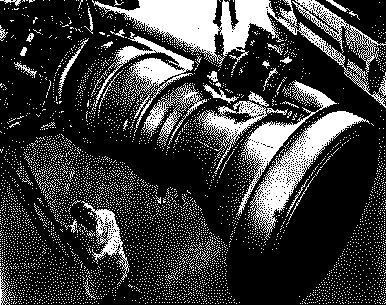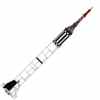
Home - Search - Browse - Alphabetic Index: 0- 1- 2- 3- 4- 5- 6- 7- 8- 9
A- B- C- D- E- F- G- H- I- J- K- L- M- N- O- P- Q- R- S- T- U- V- W- X- Y- Z
Lox/Alcohol

Redstone engine
Credit: © Mark Wade
Lox/Alcohol propellant. This propellant combination was used for the German V-2 rocket, and the first derivative rocket engines in the United States, Soviet Union, and China. Improved specific impulse was achieved by increasing the alcohol concentration in the post-war engines. But after better-performance rocket-grade kerosene was developed by Rocketdyne in the REAP program of 1953, use of alcohol was abandoned. And liquid oxygen, being moderately cryogenic, was not suitable for military uses where storage of the fuelled missile and quick launch are required.
Specific impulse: 338 s. Specific impulse sea level: 284 s. Location: 1710.
Oxidizer Density: 1.140 g/cc.
Propellant Formulation: LOX/Alcohol-75%. Optimum Oxidizer to Fuel Ratio: 1.43. Temperature of Combustion: 3,230 deg K. Ratio of Specific Heats: 1.21. Fuel Density: 0.87 g/cc. Propellant Density: 1.01 g/cc.
Propellant Formulation: LOX/Alcohol-92.5%. Optimum Oxidizer to Fuel Ratio: 1.73. Temperature of Combustion: 3,390 deg K. Fuel Density: 0.80 g/cc. Propellant Density: 0.99 g/cc.
Propellant Formulation: LOX/Alcohol-96%. Optimum Oxidizer to Fuel Ratio: 1.80. Temperature of Combustion: 3,420 deg K. Fuel Density: 0.79 g/cc. Propellant Density: 0.98 g/cc. Ratio of specific heats: 1.21. Characteristic velocity: 1,710 m/s (5,610 ft/sec). Isp shifting: 288 seconds. Isp frozen: 276 seconds.
Subtopics
| A-10 LOx/Alcohol propellant rocket stage. . |
| A-10 engine Thiel LOx/Alcohol rocket engine. Study 1942. Planned for use in A-10. Unique dual-thrust chamber / single nozzle design, which was later shown to be not feasible technically. |
| A-11 LOx/Alcohol propellant rocket stage. Masses estimated; dimensions scaled from drawing. |
| A-12 LOx/Alcohol propellant rocket stage. All values estimated. |
| A-4 stage LOx/Alcohol propellant rocket stage. V-2 production version. |
 | A-6 Rocketdyne LOx/Alcohol rocket engine. Out of production. Used on Redstone launch vehicle. First flight 1953. Developed from the XLR43-NA-1, an American version of the V-2 single-chamber engine tested in 1945. |
| A-9 stage LOx/Alcohol propellant rocket stage. Winged version. |
| DF-1-1 LOx/Alcohol rocket stage. 270.00 kN (60,698 lbf) thrust. Mass 14,000 kg (30,865 lb). |
 | G-26 Booster LOx/Alcohol propellant rocket stage. Burns out at altitude 13,000 m, Mach 3. |
| G-4 stage LOx/Alcohol propellant rocket stage. Residuals 940 kg. Burnout mass with 3400 kg warhead 7100 kg. Cutoff velocity 4500 m/s, maximum altitude 120 km over 3000 km range. With 10 G limiter thrust would be throttled back and burn time would be 156 seconds. |
| Garvey Aerospike Garvey LOx/Alcohol rocket engine. Single-chamber, liquid-propellant, annular aerospike engine. |
 | HL-10 American manned spaceplane. 37 launches, 1966.12.22 to 1970.07.17 . The HL-10 was the favored lifting body configuration of NASA Langley in the 1960's. It reached Mach 1.86 and 27,700 m during its flight tests. |
| LR39 Reaction Motors LOx/Alcohol rocket engine. Small experimental engine. Single thrust chamber, water cooled, equipped only with spark plug ignition system and propellant flow valves. Test article only built. |
| LR8-RM-5 Reaction Motors. Advanced version of the LR-11, 4 chambers. Engine in the X-1E was modified in 1958 to increase chamber pressure to 20 atm and burn Hydyne fuel. |
 | M2-F2 American manned spaceplane. Study 1966. The least stable of the lifting body designs. The 'flying bathtub' had a rounded belly / flat top layout as opposed to the flat belly / rounded top of the other designs. |
 | M2-F3 American manned spaceplane. 43 launches, 1966.07.12 to 1971.12.21 . The crashed M2-F2 was rebuilt as the M2-F3 with enlarged vertical stabilizers. Maximum speed achieved was Mach 1.6, top altitude 21,800 m. |
| Model 39 Thiel LOx/Alcohol rocket engine. Used on V-2 missile. Work began June 1936. Interim design, but went into production. Used 18 x 1.5 metric ton thrust chambers, feeding common mixing chamber. Tested from 1939, mass production 1943-1945. |
| Model 39a Thiel LOx/Alcohol rocket engine. Single chamber engine for V-2 series C, A9. Tested 1942-45. Never went into production in Germany, but formed the basis for successful post-war American and French rocket engines. |
| MX-774 Alternate designation for [Hiroc]. |
 | Quad American manned lunar lander. Study 2009. Prototype lunar lander developed by Armadillo Aerospace with private funds. Quad was the only entry in the 2006 competition for the X-Prize Cup Lunar Lander challenge. |
| R-1 stage LOx/Alcohol propellant rocket stage. Payload 815 / 483 kg. Range 270 km. Maximum altitude 77 km. Time of flight 5 minutes. Max velocity at burnout 1465 m/s. Accuracy 8 km in range, 4 km laterally. |
| R-2 stage LOx/Alcohol propellant rocket stage. Payload 1350 / 508 kg. Range 550 km. Maximum altitude 171 km. Time of flight 7.5 minutes. Max velocity at burnout 2175 m/s. Accuracy 8 km in range, 4 km laterally. |
| R-3A stage LOx/Alcohol propellant rocket stage. Further incremental upgrade of R-2. Payload 500 kg. Range 935 km. Developed from 1949 to October 1951. Cancelled, work combined with 8K14 development. |
| RD-0101 Kosberg LOx/Alcohol rocket engine. E-50A aircraft by Mikoyan. Out of Production. Chamber pressure 42,7 - 22,1 bar. Specific impulse 255 - 248,5 sec. |
 | RD-100 Glushko LOx/Alcohol rocket engine. R-1, V-1A. Russian copy of the V-2 engine using Russian materials - which made it very difficult! German rocket scientists assisted in its development. First flight 1948. |
 | RD-101 Glushko LOx/Alcohol rocket engine. R-2 and V-2A. Developed simultaneously with the RD-100 but with no German involvement. More compact, increased thrust, increased chamber pressure and higher alcohol concentration. First flight 1949. |
| RD-102 Glushko LOx/Alcohol rocket engine. R-3A. Development ended 1951. Project for R-3A experimental missile. Stopped in favor of RD-103. |
| RD-103 Glushko LOx/Alcohol rocket engine. R-5. Out of Production. Final extrapolation of the V-2 rocket engine in Russia. First flight 1953. |
| RD-103M Glushko LOx/Alcohol rocket engine. R-5M 8K51. First flight 1953. |
| RD-103RD Glushko LOx/Alcohol rocket engine. M5RD. Out of Production. |
| RD-3A Glushko LOx/Alcohol rocket engine. R-3A. Out of Production. Project for R-3A experimental missile. Stopped in favor of RD-103. |
 | Redstone Mercury LOx/Alcohol propellant rocket stage. Used for Jupiter-C satellite missions, and greatly modified, for Mercury manned positions. For Jupiter-C missions, used Hydyne fuel, which was toxic but increased specific impulse. |
| Sanger-Bredt Sled Saenger LOx/Alcohol rocket engine. Study 1943. Used on Sanger launch vehicle. |
 | Sled Technology Rocketdyne LOx/Alcohol rocket engine. Pressure-fed. From 35,000 to 150,000 lbf. Cook Sled, Air Force Sleds 1 and 2, RS-2 Sled, operated at Edwards and Holloman Air Force Bases. |
| Viking Type 9-1 LOx/Alcohol rocket stage. 93.00 kN (20,907 lbf) thrust. Mass 6,800 kg (14,991 lb). |
| Viking-1 LOx/Alcohol rocket stage. 93.00 kN (20,907 lbf) thrust. Mass 4,500 kg (9,921 lb). |
 | X-1A American manned rocketplane. Study 1951. The X-1A, B, and D were essentially identical rocketplanes intended to reach speeds above Mach 2. |
 | X-1B American manned rocketplane. Flown 1952. The X-1A, B, and D were essentially identical rocketplanes intended to reach speeds above Mach 2. |
| X-1D American manned rocketplane. Study 1953. The X-1A, B, and D were essentially identical rocketplanes intended to reach speeds above Mach 2. |
 | X-2 American manned rocketplane. Design began 1945. X-2 was an AAF/ Bell project that flew three supersonic flight research aircraft, powered by liquid rockets. Originally designated XS-2. |
 | X-24A American manned spaceplane. 28 launches, 1969.04.17 to 1971.06.04 . The X-24A was the Martin Corporation's subsonic test version of the US Air Force's preferred manned lifting body configuration. |
 | X-24B American manned spaceplane. 36 launches, 1973.08.01 to 1975.11.26 . |
 | XF-91 American manned rocketplane. The Republic XF-91 Thunderceptor was a mixed-power interceptor, being powered by both a jet engine and by a battery of rocket motors. Although it showed promise, it was not put into production. |
 | XLR11 Reaction Motors, Thiokol LOx/Alcohol rocket engine. Rocket engine developed for X-1 in 1940s to break the sound barrier and used twenty years later to power experimental lifting bodies. Four combustion chambers. |
| XLR25-CW-1 Curtiss-Wright LOx/Alcohol rocket engine. Out of Production. First flight 1954. Two chamber engine built for X-2 rocketplane. Engine could be throttled continuously from 1140 kgf to 6820 kgf. |
 | XLR43-NA-1 Rocketdyne LOx/Alcohol rocket engine. Development completed 1951. Mark III American version of single-chamber V-2 engine tested in WW2, but with half mass and 34% more thrust. Starting point for all later Rocketdyne engines. |
 | XLR71-NA-1 Rocketdyne LOx/Alcohol rocket engine. Planned engine for the booster of the Navaho II test vehicle. Gas generator, pump-fed. |
| XP-92 American manned delta-wing rocketplane. Never flown with rockets, but flew as a turbojet-powered research aircraft, 1948-1953. |
| XR3A2 XCOR LOx/Alcohol rocket engine. First stages. Hardware. The XR3A2 700-newton engine was the first XCOR LOX/alcohol engine, accumulating 61 brief runs in the course of injector concept development, which led to later engines. |
| XR4A3 XCOR LOx/Alcohol rocket engine. First stages. Fully operational pressure-fed, regeneratively cooled engine. Flown on the EZ-Rocket, a modified Long-EZ aircraft fitted with two engines. First flight 2001. |
 | XS-1 American manned rocketplane. Design begun 1943. Also known as the X-1. This rocket plane was the first aircraft to break the sound barrier, and the first in a line of X- aircraft leading to the space shuttle. |
Engines:
A-10 engine,
RD-100,
XLR43-NA-1,
RD-101,
A-6,
XLR71-NA-1,
RD-102,
RD-103,
RD-0101,
RD-103M,
RD-103RD,
Model 39,
Model 39a,
DF-1 engine,
Garvey Aerospike,
LR8-RM-5,
LR39,
NRL Viking,
RD-3A,
Sanger-Bredt Sled,
Sled Technology,
XLR11,
XLR25-CW-1,
XR3A2,
XR4A3.
Spacecraft:
XS-1,
X-2,
XP-92,
XF-91,
X-1D,
X-1A,
X-1B,
M2-F2,
M2-F3,
HL-10,
X-24A,
X-24B,
Quad.
Stages:
MX-774,
Sanger Sled,
G-26 Booster,
A-10,
A-11,
A-12,
A-4 stage,
A-9 stage,
R-1 stage,
G-4 stage,
R-2 stage,
R-3A stage,
Viking Type 9-1,
Viking-1,
DF-1-1,
Jupiter A stage,
Redstone Mercury.
Back to top of page
Home - Search - Browse - Alphabetic Index: 0- 1- 2- 3- 4- 5- 6- 7- 8- 9
A- B- C- D- E- F- G- H- I- J- K- L- M- N- O- P- Q- R- S- T- U- V- W- X- Y- Z
© 1997-2019 Mark Wade - Contact
© / Conditions for Use

